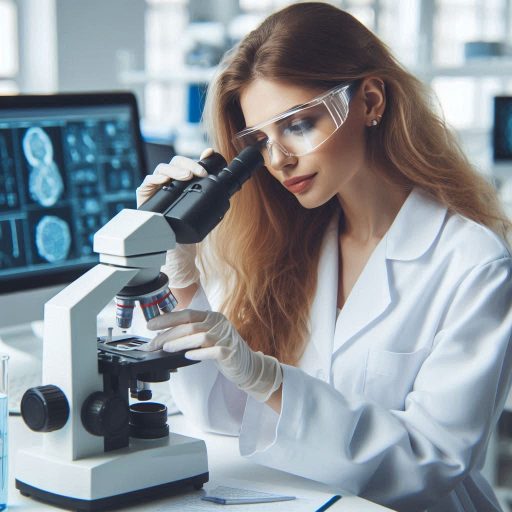Introduction
A biostatistician plays a crucial role in healthcare, medicine, and biological research by applying advanced statistical techniques to analyze and interpret data.
They help design experiments, collect data, and use statistical tools to draw meaningful conclusions that inform public health decisions, medical treatments, and scientific research.
From clinical trials to epidemiological studies, biostatisticians provide the foundation for evidence-based decisions, ensuring that medical and biological research is both reliable and accurate.
Statistical analysis is essential in gathering, organizing, and interpreting complex biological and medical data.
Biostatisticians use their expertise to help researchers make sense of data related to disease patterns, treatment outcomes, and healthcare effectiveness.
This process enables scientists and healthcare professionals to understand how treatments work, identify trends in public health, and improve patient care.
In a data-driven world, the work of biostatisticians is becoming increasingly important.
Their ability to translate large, complex datasets into actionable insights allows for breakthroughs in medical research, improved healthcare policies, and innovations that enhance patient outcomes.
By ensuring data accuracy and integrity, biostatisticians contribute significantly to the advancement of medicine and biological sciences.
Their expertise underpins much of the progress in fields like genetics, cancer research, and population health, making them indispensable to modern healthcare and science.
Education and Training
When considering a career as a biostatistician, it is important to understand the educational requirements and training needed to excel in this field.
Biostatisticians play a critical role in the design, analysis, and interpretation of data in biological and health-related research studies.
Let’s delve into the typical educational path for aspiring biostatisticians and the importance of pursuing advanced degrees for career growth and advancement.
Typical Educational Requirements
To start a career as a biostatistician, a bachelor’s degree in statistics, mathematics, or a related field is usually required.
Coursework in calculus, linear algebra, probability, and statistics is essential to build a strong foundational knowledge in quantitative methods and data analysis.
Additionally, courses in biology, epidemiology, and public health can be beneficial for understanding the application of statistical methods in health research.
Many universities offer specialized programs in biostatistics at the graduate level.
Pursuing a Master’s degree in biostatistics can provide in-depth training in statistical theory, advanced data analysis techniques, and software tools commonly used in the field.
Some programs may also include coursework in research methodology, data management, and the ethical considerations of conducting research involving human subjects.
Importance of Advanced Degrees
While a bachelor’s degree can open the door to entry-level biostatistician positions, advanced degrees, such as a Master’s or PhD, are often needed for career advancement and leadership roles in the field.
A Master’s degree in biostatistics can enhance analytical skills, research methodologies, and the ability to communicate complex statistical concepts to diverse audiences.
A PhD in biostatistics offers even greater opportunities for specialization and research in specific areas of interest within the field.
Doctoral programs typically involve advanced coursework, thesis research, and collaboration with faculty members on cutting-edge research projects.
Graduates with a PhD in biostatistics are well-equipped to lead research teams, develop innovative statistical methods, and contribute to the advancement of knowledge in biological and health sciences.
Basically, the path to becoming a successful biostatistician involves obtaining the necessary education and training to develop expertise in statistical methods and data analysis.
While a bachelor’s degree is a good starting point, pursuing advanced degrees in biostatistics can significantly enhance career opportunities and enable professionals to make meaningful contributions to research and public health initiatives.
By investing in advanced education, aspiring biostatisticians can position themselves for long-term success and leadership in the dynamic field of biostatistics.
Read: Challenges and Rewards: The Dual Life of an U.S. Environmental Scientist
Job Duties
Outline the Primary Responsibilities of Biostatisticians
One of the primary responsibilities of biostatisticians is designing research studies.
They create study protocols that outline the methodology, sample size, and statistical approach.
This step is crucial to ensure the research produces reliable and valid results.
Biostatisticians must account for variables, biases, and potential errors in the design phase.
Once the study design is finalized, biostatisticians oversee data collection.
They ensure the data gathered is accurate and follows strict guidelines.
This may involve collaborating with field researchers or health professionals to ensure proper data entry and management.
Biostatisticians often use specialized software to organize and clean the data before analysis.
The next critical task is data analysis.
Biostatisticians use statistical methods to interpret the collected data.
They apply techniques like regression analysis, hypothesis testing, and modeling to draw conclusions.
These analyses help researchers understand patterns, trends, and relationships within the data.
After analyzing the results, biostatisticians report their findings in a clear, concise manner, often contributing to scientific papers or medical reports.
How Biostatisticians Work Closely With Researchers and Healthcare Professionals to Ensure Data Accuracy and Validity
Biostatisticians work in close collaboration with researchers and healthcare professionals throughout a study.
From the initial planning stages, they help design studies that meet rigorous scientific standards.
They ensure that every aspect of the study, from participant selection to data collection, is methodologically sound.
This collaboration is essential for ensuring the study produces credible results.
During the data collection phase, biostatisticians communicate regularly with research teams.
They monitor the data being collected to detect any issues early on.
This real-time oversight helps maintain data accuracy and prevents errors that could impact the study‘s outcomes.
Their involvement ensures that data collection follows the proper protocols, minimizing biases and discrepancies.
Biostatisticians also play a pivotal role during the analysis phase.
They work alongside researchers and healthcare professionals to interpret the data.
Their statistical expertise is critical for understanding complex data sets and drawing accurate conclusions.
By providing clear statistical analyses, biostatisticians help ensure that healthcare professionals and policymakers base their decisions on valid, reliable data.
Read: Job Market Trends: Future of Chemistry Jobs in America
Statistical Analysis
Statistical Methods Used by Biostatisticians
Biostatisticians use various techniques to analyze healthcare data.
One common method is regression analysis, which helps model relationships between variables.
This technique can predict patient outcomes based on factors like age, treatment, or medical history.
Another essential method is survival analysis, which estimates the time until an event occurs, such as disease progression or patient recovery.
This technique is widely used in clinical trials to evaluate treatment effectiveness.
Bayesian methods are also popular among biostatisticians.
These methods incorporate prior knowledge or evidence to improve decision-making.
For instance, Bayesian approaches are often used in genetic studies to predict disease risks based on known genetic markers.
In addition, biostatisticians may apply machine learning algorithms to large datasets, identifying patterns and trends that may be missed with traditional analysis techniques.
These methods are increasingly valuable as healthcare data becomes more complex and voluminous.
Helping Interpret Complex Data
Biostatisticians interpret complex healthcare data, making it comprehensible for healthcare providers and researchers.
For example, in a clinical trial, biostatisticians analyze treatment outcomes to determine which therapies are most effective.
They present the results in a clear, actionable format that helps doctors make informed treatment decisions.
Biostatisticians also assist in public health by analyzing population data to identify trends in disease outbreaks.
Their analyses help policymakers develop strategies to prevent the spread of diseases and improve public health interventions.
In research settings, biostatisticians collaborate with scientists to design experiments and studies.
They ensure that data is collected and analyzed properly, which helps produce reliable and accurate results.
For instance, biostatisticians play a critical role in drug development, where they evaluate the safety and efficacy of new medications.
By interpreting data from clinical trials, they help ensure that only safe, effective drugs reach the market.
Informed Decision-Making in Healthcare and Research
Biostatisticians‘ work is crucial in making informed decisions in healthcare.
They ensure that data is not only accurate but also meaningful.
For example, their analysis can reveal whether a new treatment reduces the risk of heart disease or helps cancer patients live longer.
In research, biostatisticians guide the decision-making process by interpreting data trends and predicting future outcomes.
Their ability to synthesize complex datasets allows researchers and healthcare providers to take evidence-based actions.
Therefore, biostatisticians combine statistical expertise with healthcare knowledge to interpret complex data.
By using techniques like regression analysis, survival analysis, and Bayesian methods, they support informed decision-making in healthcare and research settings, contributing to the advancement of medicine and public health.
Read: Challenges and Rewards: Navigating the Chemist Career Path

Software and Tools
Importance of Using Statistical Software Such as SAS, R, and SPSS in Biostatistics
Statistical software is essential for biostatisticians, enabling them to analyze complex data quickly and accurately.
Programs like SAS, R, and SPSS are popular in the field due to their advanced capabilities.
Each of these tools offers unique features that are critical for handling different types of data and statistical models.
SAS (Statistical Analysis System) is widely used in biostatistics due to its powerful data management and analytical abilities.
It provides an array of statistical methods and procedures that make it easier to manipulate, process, and analyze large datasets.
R is an open-source software that has become a favorite among biostatisticians because of its flexibility and extensibility.
Its wide range of packages allows users to perform complex statistical computations and data visualization.
Additionally, SPSS (Statistical Package for the Social Sciences) is another essential tool for biostatisticians, offering an intuitive interface for data analysis, particularly in social and biomedical research.
These tools have become indispensable in biostatistics because they streamline the analysis process and ensure accurate results.
How Biostatisticians Leverage These Tools to Streamline Data Analysis and Generate Accurate Reports for Stakeholders
Biostatisticians rely on statistical software to perform their job efficiently.
With these tools, they can automate tasks that would otherwise take hours to complete manually.
For example, using SAS, biostatisticians can input vast amounts of raw data, run advanced statistical tests, and generate detailed reports in a matter of minutes.
In R, biostatisticians can write custom scripts to perform highly specific analyses, such as survival analysis in clinical trials.
The ability to write code makes R particularly useful for researchers dealing with complex datasets.
It also provides tools for creating high-quality visualizations, making data easier to interpret for stakeholders.
With SPSS, biostatisticians can quickly generate descriptive statistics, which provide summaries of large datasets.
This software is particularly useful in public health research, where understanding trends and patterns in the data is crucial for making informed decisions.
Biostatisticians use these tools to ensure that their analyses are reproducible, a critical component in scientific research.
The software allows them to maintain consistency, eliminating human errors that could affect results.
After analyzing data, biostatisticians use the software to generate reports and visualizations that present findings clearly to stakeholders, including healthcare professionals, researchers, and policymakers.
Generally, mastering statistical software such as SAS, R, and SPSS is crucial for any biostatistician.
These tools streamline the data analysis process, enabling biostatisticians to work more efficiently and deliver accurate, insightful reports to their stakeholders.
The ability to leverage these tools sets biostatisticians apart as experts in transforming raw data into actionable insights.
Read: Diverse Career Paths: From Chemist to Patent Attorney in the US
Career Opportunities
The Diverse Career Paths Available to Biostatisticians
Biostatisticians enjoy a wide range of career opportunities in different sectors.
Pharmaceutical companies are one of the leading employers, where biostatisticians design and analyze clinical trials.
Their role is crucial in ensuring that new drugs and treatments are both safe and effective.
They analyze the data collected from clinical trials to assess outcomes and guide regulatory approvals.
Government agencies also employ biostatisticians.
For example, the Centers for Disease Control and Prevention (CDC) and the Food and Drug Administration (FDA) rely on biostatisticians to help monitor public health trends, design epidemiological studies, and evaluate treatment effectiveness.
Working in government positions provides the opportunity to impact public health policies and initiatives.
Another potential career path is in academic institutions.
Biostatisticians in academia often collaborate with researchers to design experiments, analyze data, and publish findings.
These positions allow for contributions to scientific knowledge and may involve teaching roles, where biostatisticians can train future researchers and scientists in the field.
Growing Demand for Skilled Biostatisticians in Healthcare and Research Fields
The demand for skilled biostatisticians is rapidly increasing, driven by the rise of big data and advancements in healthcare technology.
As more data becomes available from electronic health records and genomic studies, biostatisticians are needed to interpret these vast amounts of information.
Their ability to turn raw data into actionable insights makes them invaluable in both healthcare and research sectors.
In healthcare, biostatisticians are essential for analyzing patient data, improving treatment protocols, and developing predictive models for disease outcomes.
Hospitals, research centers, and biotechnology firms rely on biostatisticians to guide decision-making and optimize patient care.
Their role is integral to precision medicine, where treatments are tailored to individual genetic profiles.
Research fields also see a growing need for biostatisticians, particularly in epidemiology, genetics, and environmental health studies.
Their expertise helps identify risk factors for diseases, evaluate public health interventions, and contribute to understanding global health issues like pandemics.
This makes biostatisticians indispensable in efforts to improve population health.
Potential for Career Growth and Advancement
The potential for career growth in biostatistics is significant.
As the demand for biostatistical expertise grows, opportunities for advancement increase.
Biostatisticians can move into senior roles such as lead statistician or become directors of biostatistics departments.
In addition, many professionals in this field go on to manage entire research projects, overseeing multidisciplinary teams.
In review, biostatistics offers diverse career paths in pharmaceuticals, government, and academia.
The demand for biostatisticians continues to rise, offering strong potential for career growth in both healthcare and research fields.
You Might Also Like: Latest Research in Plant Science 2024
Salary and Job Outlook
The Average Salary Range for Biostatisticians, Based on Experience, Education, and Industry
Biostatisticians enjoy competitive salaries, which vary depending on factors like experience, education, and industry.
Early-career professionals typically earn between $60,000 and $80,000 annually.
With more experience, those figures can rise substantially.
Mid-career biostatisticians often make between $90,000 and $120,000.
Education level also significantly impacts salary.
Biostatisticians with a master’s degree earn higher than those with a bachelor’s degree.
However, professionals with a Ph.D.in biostatistics or a related field can command salaries exceeding $130,000 annually.
The industry in which a biostatistician works plays a crucial role in salary determination.
Biostatisticians working in pharmaceutical companies, biotechnology firms, and government agencies tend to earn higher salaries.
Those employed in academia may receive slightly lower salaries but often benefit from other perks like research opportunities.
Location can also influence pay, with biostatisticians in major cities and regions with a high demand for healthcare professionals generally earning more.
The combination of these factors provides a wide range of potential earnings in this growing field.
Transform Your Career Today
Unlock a personalized career strategy that drives real results. Get tailored advice and a roadmap designed just for you.
Start NowProjected Job Outlook for Biostatisticians, Including Factors Contributing to Job Growth
The job outlook for biostatisticians is highly positive, with rapid growth expected over the next decade.
Demand for professionals in this field is driven by several key factors.
First, advancements in healthcare technology have led to an increased need for data analysis to improve patient care.
Biostatisticians are essential in analyzing large datasets from electronic health records and clinical trials, helping to identify trends, patterns, and potential solutions for health challenges.
In addition to technological advancements, the aging population significantly boosts demand for biostatisticians.
As the global population ages, the need for medical research to address age-related diseases increases.
Biostatisticians play a pivotal role in developing and analyzing studies on aging, chronic illnesses, and long-term care.
Their expertise is crucial in understanding the effectiveness of treatments, interventions, and healthcare policies aimed at improving quality of life for older adults.
Biostatisticians are also in demand for pharmaceutical research, drug development, and epidemiology studies.
The COVID-19 pandemic further emphasized the importance of biostatistics in public health, contributing to an increased interest in this profession.
Overall, the Bureau of Labor Statistics projects a faster-than-average job growth rate of 30% from 2020 to 2030 for biostatisticians.
This promising outlook, coupled with competitive salaries and opportunities in various industries, makes biostatistics an attractive and rewarding career choice.
In essence, biostatisticians enjoy excellent career prospects with competitive salaries based on experience, education, and industry.
With the growing need for healthcare data analysis and research, this field offers significant job opportunities for those interested in making a meaningful impact on public health.
Conclusion
Biostatisticians play an essential role in healthcare and research, using their expertise to analyze complex data and improve patient outcomes.
Their work is fundamental in designing studies, interpreting results, and guiding critical decisions in medical research.
By applying statistical methods, biostatisticians help identify disease patterns, develop new treatments, and optimize clinical trial efficiency.
Their contributions enable researchers to make data-driven decisions that impact public health and advance medical knowledge.
Biostatisticians serve as the bridge between data science and healthcare, ensuring that medical decisions and policies are informed by accurate statistical analysis.
Whether in academia, government agencies, pharmaceutical companies, or public health organizations, biostatisticians contribute to a broad range of fields.
Their work enhances the quality of healthcare systems, improves drug development processes, and influences public health strategies.
If you’re passionate about data and interested in contributing to healthcare advancements, a career in biostatistics could be incredibly rewarding.
The demand for skilled biostatisticians continues to grow as healthcare systems increasingly rely on data-driven insights.
This field offers diverse and exciting career opportunities where you can make a meaningful impact.
By exploring a career in biostatistics, you can contribute to shaping the future of healthcare, improving patient care, and advancing medical research for generations to come.




